#he explores the mastery of the actor's mindset
Explore tagged Tumblr posts
Text
Rajkummar Rao and the Art of Character Transformation

In the Indian film industry, certain actors go above and beyond to embody the characters they are playing. Rajkummar Rao is an exceptional example of this. Rather than simply acting out a role, he delves into the emotional and physical depths required to bring the character to life on screen. Below we explore some of Rao's most notable physical and emotional transformations, with a spotlight on his staggering performance in 'Trapped'.
Total Immersion An extraordinary aspect of Rao's acting is his commitment to complete, immersive transformation. He becomes his characters, adjusting his body, speech, mindset, and often even living conditions, to align fully with the role he is playing. He places great importance on understanding the psychological and emotional makeup of his characters, which enables him to portray them convincingly.
Drastic Physical Transformations Rao's dedication to his craft often demands extreme physical metamorphoses. For instance, in the movie 'Trapped', he played a man stuck in an empty high-rise without food, water, or electricity. Rao literally starved himself to authentically portray the physical deterioration his character undergoes. His alarmingly gaunt appearance in the film bore testimony to his commitment.
In the biographical drama 'Bose: Dead/Alive', Rao played the titular role of Subhash Chandra Bose, a notable figure in India's fight for independence. To augment his physical likeness to the character, Rao gained around 11 kilograms, reflecting his dedication to create an authentic portrayal.
Emotional Depth Rao's emotional transformations are no less profound. In 'Shahid', he portrayed a lawyer who defended those accused of terrorism, a role demanding great emotional depth and sensitivity. Rao's performance was lauded for his empathetic portrayal of Shahid Azmi's internal struggles and pains.
Rao's role in 'CityLights', where he plays a migrant from Rajasthan trying to make ends meet in the bustling city of Mumbai, required an emotional transformation. His portrayal of a naive villager adapting to the harsh reality of city life was both moving and visually persuasive.
Honest Performances Rajkummar Rao's mastery over his craft is evident in the sheer honesty of his performances. Whether it be the physical transformation he undergoes or the raw emotions he brings to his characters, his work breathes authenticity.
In conclusion, Rajkummar Rao exemplifies the true art of character transformation. He goes beyond surface-level performances, plunging into physical and emotional depths to breathe life into his characters, making his roles truly notable in the landscape of Indian cinema.
0 notes
Text
Rocky IV (1985)

Confession time: this is the first Rocky movie I’ve ever seen. Sure, I know the “iconic moments” or whatever, but I came into this not knowing a lick about the Italian Stallion. Fortunately for me, there was a handy montage half an hour or so into the movie that DEFINITELY wasn’t padding it for time to help explain previous fights Balboa had been in. It’s always the same story arc anyhow, far as I can tell: scrappy fighter overcomes the odds to put up a fight (even if he doesn’t win, like in the first one—I know that, too!). Sylvester Stallone’s ego had passed that point by the fourth iteration, so of course Rocky here has to completely defeat the Soviet mindset. This fight is so much more than just a bout of boxing, as a song reminds the viewer. It’s you against you. East versus West, or man against man? Such are the deep thoughts of this writer-director-actor-mumbler.
Among other things, this movie is certifiably the least gay piece of cinema ever to grace the silver screen. Dudes frolicking on the beach as the song lyrics “Hearts on fire / Strong desire” play? Straight af. Cameras panning lovingly over sweaty male bodies? Someone dial 1-800-HETERO-STUFF. The protagonist showing up late to a birthday because he’s too busy with punchy foreplay with aforementioned beach frolicking partner and then abandoning wife and son to avenge his death? Top 10 Things Oscar Wilde Definitely Would Never Have Written. Sports movies always seem to flirt with the not-gays, but not every movie features such lavish explorations of the trope as this.
Montages. Holy fucking shit. The montages on this thing. It must be at least a third just dudes working out as music plays. Stallone must have heard about that whole show-don’t-tell thing and taken it to its logical extreme, layering sequence after sequence that contrast the laboratory precision of Ivan Drago’s workout routine (complete with glaring red lights, because, y’know, he’s a Commie) against the homespun ingenuity of Rocky Balboa sawing longs and chopping down trees. There’s even a recap montage over the credits for those with the attention span and recall ability of goldfish.
Intense nationalism is also at the fore, and fault can be found on both fronts. Make no mistake, the film is ‘merican and works double overtime to remind the viewer of that in back-to-back montages contrasting Rocky’s scrappy wilderness training routine against Ivan’s cocktail of anabolic steroids and precision-science-stuff gym workouts, all culminating in potentially the worst helicopter shot of all time as Rocky bellows Drago’s name from a mountaintop. But in the ring, shallow showmanship is king. Before Apollo Creed’s doomed exposition match, the lead-up to the American combatant’s introduction borders on farce: this is the American excess that Soviets so stereotypically despise. An Uncle Sam’ed up Creed flounces among hordes of showgirls as James Brown belts “Living in America.” It becomes almost embarrassing to witness this athlete skirting that border between confidence and hubris as Drago stares on, a mixture of confusion and cultivation of hatred. But the Russian athlete isn’t free of guilt: the USSR national anthem features a massive poster of Ivan Drago, their new golden god, in a less showy but more politically effective demonstration of mastery. The moments very clearly parallel in their “pride goeth before the fall” sentiment. Rocky states everyone can change in a closing speech, but perhaps some things remain constant.
THE RULES
SIP
Slo-mo
A song begins. HEARTSSS ON FIIIIIIRE
Dolph Lundgren has really pillowy lips.
Intense sweatiness.
Rocky pushes Ivan in the ring.
Talk of age.
BIG DRINK
Hammer and sickle imagery in a scene.
The robot shows up.
LIVER TRANSPLANT WAITLIST MODE
Sip every time Sylvester Stallone is just impossible to understand. He’s like the proto Vin Diesel.
#drinking games#rocky iv#rocky#action#action & adventure#drama#sylvester stallone#dolph lundgren#hearts on fire#strong desire
7 notes
·
View notes
Text
Conspiracism and Nihilism

So let's ruminate and dissertate on the commonalities and differences between conspiracism and nihilism. Conspiracism is a general world view that sees history as driven primarily by interwoven webs of secret conspiracies. Within conspiracism, there are conspiracy theories, which are leaner narratives, more specific, and more limited in scope. A conspiracy theory often alleges that a secret plot involving hidden actors is behind particular historical events. And so I'm glad that we have finally come to address this particular subject, as it is a symptom of an insidious pervasive spiritual sickness that has come to infect the minds of modern men. It is a dangerous addiction to get involved in, and it's propagation represents a profound malevolent misdirection, which further ensures even deeper misdirection through the interaction and consumption of it. But before we delve deeper into that, let us first ask: how is conspiracism related to nihilism? It is related to nihilism in a dark sense, that is, with the most commonly understood interpretation of nihilism: a type of misanthropic philosophy with a negative implication. And before any of you object, I am not saying this about conspiracism because people believe that this is true, I'm saying this because, I already know people don't believe it's true, and I am here to tell you that, no, you are wrong, it is most certainly true. Conspiracism is profoundly nihilistic, because it negates many vital components of your existential being. The main one being, the basic innate unconscious trust of the context of your experience. Therein, anxiety, paranoia and delusions ineluctably follow. It's the type of negation that renders an existential explorer dysfunctional and eventually completely defunct, as they are no longer able to learn or unlearn, as paranoid suspicion negates the value of ALL existential applications, good and bad; so the truth gets grouped in with all the lies and the baby ends up getting thrown out with the bath water; resulting in a deep mire down a slippery slope dead end swallowing pit of quicksand. This is what conspiracism ultimately culminates into. It may start small, with just a few minor theories about isolated events, but if followed further and given more time, energy and focus, it will inevitably start have an accumulative effect, eventually snowballing into a full blown detrimental mindset; note that the word mental is in the word detrimental. It is indeed specifically detri-mental, as illusory appearances within sensory perception are all mental in nature...
So, this is a contagious infectious disease of the mind, a dis-ease of the mind, and for so long as a mind is not at ease, a mastery of mind can never be realized. Distrust is like a ruthless fire that spreads further and further, raging out of control, consuming anything and everything in it's path. And while this circumstance is indeed disconcerting, distrust isn't the real foundation of the problem, as distrust is only a sign of a much deeper issue. So running around trying to put out the flames of the ruthless fire is addressing the wrong area of concern, as distrust itself is only an indication of a sickness with a much deeper root cause. Distrust isn't the source of power fueling negative manifestations. It is only one of many symptoms. What gives rise to the distrust, and lures a consciousness towards conspiracism in the first place, is fear. Fear is resistance, and resistance is the friction that causes the spark that produces the flames of the fire that burn and destroy everything. Fear is the antithesis of a calm mind, and without a calm mind, true nature cannot be realized. The key to solving this existential quandary is in letting go, and allowing the mind the peace and serenity necessary to recognize it's true nature. This is done by shifting the focus of attention away from the appearances of sense perception, and instead, focusing it onto the source of the attention itself. To get caught up in the reflected details of the 5 senses is to lose clarity of their source; and losing the clarity of their source is what creates the delusional ignorance that wrongly identifies perceptibles as separated objects to be desired or feared. This is why you can't fake it till you make it. Enlightenment isn't attained, or something that happens to a character. This is why whether or not you are actually awake isn't an ambiguous discernment to make by the truly wise. It's obvious and able to be determined within minutes, usually upon the opening of your mouth. The second you point outwards towards the field of percievables with attributions, it is already known that you are deluded. And there are no, "yeah but what abouts", as many of you may feel inclined to implore.
Understanding that everything that appears in the field of perception is mental phenomena means that there isn't anything that is an exception. Paranormal phenomena isn't an exception. Divine phenomena isn't an exception. There simply are no phenomenal aspects of experience that are exceptions. And this is why conspiracy theory is so particularly treacherous, and the agents who herald the message are so particularly malignant. Nothing serves the agenda of evil more efficiently then pointing at the details of sensory information and entreating people to get caught up in it. And boy do people get caught up in it... with religion always seeming to be the first in line. Theists are the best known faction to get caught up in conspiracy, as modern society has become the embodiment of satanism for them, which just goes to show that religion has always been the original mother of all conspiracy theories, replete with fantastic mystical narratives, doomsday prophecies, and epic battles against agendas of deception and corruption serving as much of the meat of it's myths... but we also see it in other groups, usually with interests in politics, social activism, paranormal investigation, and the new age movement; fields of intrigue that have natural inclinations towards the analysis of truth and falsehood, and an assumed advocacy of moral righteousness. These types of people are the most susceptible to lure of conspiracism; many of whom are of good intentions. But you know what they say. Just ask the theist. The road to hell is paved with good intentions. Ooooh! Sounds like a conspiracy!
But seriously, if you want to be taken seriously, you need to let go of the conspiracy mongering... as to even be involved with it discredits your legitimacy. But that's part of the conspiracy, isn't it? It's just what the shadow agenda wants! To discredit all conspiracy theory as a domain of kooks and nut jobs, right? Well, you've done a good job of this all by yourself, entertaining absurd far fetched notions concerning such things as lizard people, flat planets, and the evils of science and technology, whose forbidden inquiries have given rise to quantum fluctuations that change things in reality, seemingly with a exclusive penchant for altering the spelling and grammar of pop culture art and commercial products! Yeah. So the shadow agenda doesn't need to do anything; as you discredit yourself with so much of this nonsense. But I know what you are thinking, and I don't want any of you to get the wrong idea; as this seems to suggest that there are dependable conspiracies and unreliable conspiracies; and that one needs only to discern between those that are true, and those that are false... but this is another layer of deception, as there are no conspiracies that warrant your attention. I say this with the most emphasis to the new agers, whose motives often seem to waver back and forth between spirituality and conspiracism. This is a dangerous fence to straddle, as it isn't a position with an interest in the truth. If you want to concern yourself with the affairs of the world of men, then drop the spirituality and go back to politics or social activism; as true spirituality has no place for conspiracy theory, or any other kind of ideology whose purposes are aimed at making changes to the surfaces of illusions.
And by the way, in case you didn't get the latest conspiracy theory memo, things like enlightenment, detachment, eastern philosophy, DMT and the pineal gland, are now officially a part of the conspiracy theory canon, as they have been identified as components of the nefarious agenda! That's right. But it makes sense, doesn't it? Illumination... Illuminati... So this must mean that enlightenment is evil! The opportunity to gain a clarity of mind that is able to discern between the truth of awareness and the lie of illusory perceivables, is to be avoided at all costs! Instead, just focus on the face value of the percievables! Yeah, never mind the truth, it's evil. Just keep focusing on the distractions. Everyone knows this. Just ask Alex Jones: a man who never met a conspiracy theory he didn't like. He'll get you facing in the wrong direction fast enough. Ergo, getting back to the original point leveled at the new ager: It's a disservice to be speaking about enlightenment and conspiracy theory within the same teachings, as they contradict each other and are wholly incompatible. The truth is found by looking within, not by looking without. Focusing on illusion begets delusion, while focusing on awareness fosters clarity of mind. I know that evil, corruption and injustice are hard baits to pass up existentially, but you must remain vigilant in the mastery of your mind, lest you fall prey to the seduction of illusion. A nightmare is never overcome by breathing more life into it via validation through fear, resistance and macro focus on it's details. This approach only bolsters and sustains the nightmare. A nightmare is overcome through detachment, brave abandon and re-directing the focus of attention towards the source of the nightmare, which reveals these negative manifestations to be projections of the mind. This is called lucidity; a mental state of clarity that dissipates all nightmares.
So if you fancy yourself a so called truther, or as some kind of champion of ethics and honor, then you will stop enabling falsehoods. As, that's all you are doing with conspiracy theory. This is something conspiracy theorists should really consider, as most of you are perpetuating evil unintentionally, and are fostering a lie, with the false notion that you are somehow blazing a trail of truth and righteousness: unaware that the actual underlying conspiracy beneath all conspiracies is the use of conspiracy itself to cause distraction, foster wickedness and discredit authentic avenues to the truth of existence. And this is important to understand, as once this surreptitious disposition takes root in a mind, it renders the adherent virtually worthless, and moves them beyond the point of all possible reclamation. For, what good is a so called truth seeker if they can't tell the difference between a truth and a lie. What good is a so called truth seeker if they can't even tell the difference between the tools of liberation and the tools of slavery. Of what use is a person to the truth if they are forever paranoid, trustful of nothing and suspicious of every little thing, no matter how trivial? It's the type of mindset that cannot learn anything new, as any new information has to be skewed to fit the conspiracy narrative, and it also cannot unlearn, which is a crucial element of awakening, now completely inaccessible to the conspiracist due to the stupidity of his own blind obstinance. It's one thing to be skeptical, but once you start becoming so extremely distrustful that you begin to condemn even the things that can free your mind, you have moved beyond skeptical and become an impediment to the truth and an agent of disservice.
So, verily, I say unto you: pull the plug on conspiracy theory. Negate it. And this shouldn't be too hard, as, if you are a conspiracist, then you are already a nihilist... as you have negated many of the salient facets of your existential being... so, since you are already proficient in negating aspects, why not employ nihilism in a positive application and use it to detach from that which is false... thereby creating the proper conditions to facilitate intimacy with what is true.
And I know after everything I've just said, some of you are saying, Yes, of course the Meta Sage is asking me to abandon conspiracism, because he's part of the conspiracy! He's just an agent of the evil agenda. Right?
Sigh.
You're never gonna be able to move forward until you negotiate this hurdle. If you ever do, I'll be waiting. And so, until then, I leave you with this:
So many of the great warriors among us never even get a chance to train and master their minds because they are far too busy trying to fight evil and save the world.
Hang up the spandex. Don't waste your time trying to be a hero for illusion. Realize awareness, and everything else will fall into place.

0 notes
Text
#ReadingFilms: Riveting and Quite Extraordinary
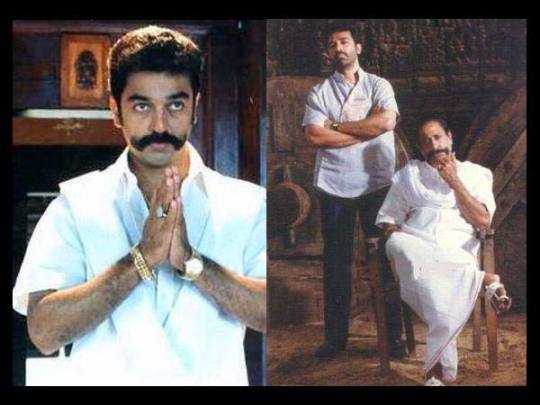
‘Thevar Magan’ (‘Son of Thevar’) (1992) Directed by Bharathan Written by Kamal Haasan Starring Kamal Haasan, Sivaji Ganesan, Gouthami, Revathy, Nassar
I do not recall the name but one prominent film critic associates the origination of the persona (or the archetype) of the mustachioed, aruvaal wielding Tamizhan in cinema to Kamal Haasan’s performance in Thevar Magan.
The film is still fresh, powerful and a poignant representation of a world and a culture outside the walls of Madras.
I’d Iike to give this essay a bit of structure by drawing 3 overarching points and building my analysis thereon up.
1. The Story and Themes
‘A westernized young man returns to his village. Unaware of feuds, customs and their implications he pulls himself into a world of sabotage and pain. When it was time, he sacrifices his love and his dreams for the sake of the people for whom his family has been responsible for centuries.’
This is Thevar Magan in a nutshell. It is an extraordinary take on the lives and the dreams of Young India in relation to the history and culture that fuels its villages.
a. Karma Yoga

At a very high level (at least for me) is the idea that the film is an interesting exposition on the concept of Karma Yoga.
Karma Yoga or the Yoga of Action is a form of Yoga based on teachings in the Bhagavad Gita. Karma Yoga is the process of achieving perfection in selfless action. It is primarily the practice of selfless service to humanity whereby a spiritual seeker attempts to give their actions selflessly without hoping for merit, fame or glory.
Kamal Haasan’s character, Saktivel, is the seeker in the context of the film. He becomes a vignette for what a modern Karma Yogi ought to be as every action he takes in the film is one keeping in mind the unity and the prosperity of his people. I think a film is a terrific canvas where one can paint ideas of sophisticated theology or philosophy, making heavy-duty concepts extremely accessible to the masses.
b. The Greater Good

Another concept we can find in the film is the concept of the Greater Good in the context of love. Love, I think, is an interesting lens through which one might view the Greater Good because it really goes against the idea of Man being a selfish, lust-driven, seeker.
Along similar lines the film also makes a claim that ego is not necessarily an evil cognitive tool - it’s, in fact, a wonderful apparatus for one to hold on to his/her self-respect and word of honor - concepts which are core ideologies in any walk of life.
Another bit of the film that caught my attention with respect to the Greater Good is one involving Saktivel’s hair. Westernised and well-initiated in the art of punk, Kamal Haasan’s mullet represents the Young Indian’s propensity in absorbing and applying the western notion of cool. But when the time comes that which is modern and that which is cool must not stand in the way of doing that which is right. In the film it involves Saktivel sacrificing his punk appeal to be reborn as the leader and caregiver of his community.
c. Culture and Community

The film received a bit of backlash upon its release because people thought that the film painted a picture of the Thevar community in Tamil Nadu as a bloodthirsty lot. However, in my opinion, the film does great justice and respectfully sheds light on the history and accomplishments of the Thevar community. From being the first recruits in Subhash Chandra Bose’s Indian National Army to being responsible for the welfare, prosperity, and justice-related issues in the village, the story is in fact very educative about the Thevar community’s involvement in social progress. I think its very unfair that social activists spotlight one aspect of the story over the cumulative exposition.
There is a debate among viewers on what the film truly intends on representing. A faction of viewers believes that the film is a treatise on violence and bloodshed. Another faction believes the film is a celebration of the Thevar community’s way of life. But by far the most interesting thematic opinion revolves around the concept of a son’s reluctance to enter and take control of the family business upon the father’s passing; a theme very wonderfully explored and inspired by Francis Ford Coppola’s ‘The Godfather’.
2. The Cast
Thevar Magan released in what may have been the greatest decade in Tamil Cinema - the decade of Kamal Haasan. This was the decade that not just Tamil Cinema, but Indian Cinema, by and large, caught a glimpse of Kamal Haasan’s artistic genius. He performed the roles of a writer, actor, producer, dancer, singer (and probably even that of a director) cementing his genius as one of India’s greatest ever Artists.
Kamal Haasan was able to play the role of Saktivel so convincingly because he understood the climate and the nature of the characters who were involved in the story and their relation to Saktivel.
Apart from the performances of Kamal Haasan, Gouthami and Revathy I think the film really played to the strengths of two of the finest actors in the history of Indian Cinema - Sivaji Ganesan and Nassar.
a. Sivaji Ganesan
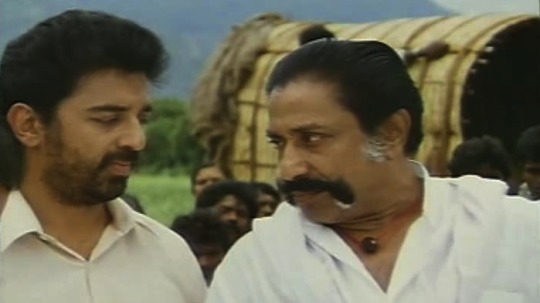
The legendary Sivaji Ganesan’s role in the film was brief but the character’s impact echoed throughout the film. The Godfather metaphor makes the point clearer - although The Godfather’s main protagonist is Michael, Vito Corleone’s reputation, power, and influence looms over Michael and the story. The same is true of Periya Thevar’s impact on the story.
b. Nassar
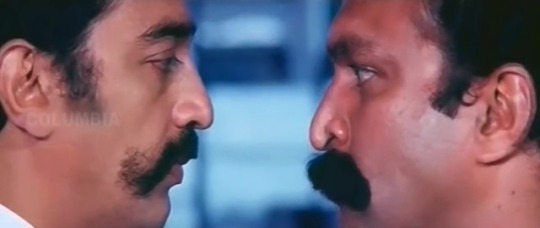
In my opinion, it was Nassar’s performance of the revenge-crazed Mayandi Thevar that stole the show. Nassar belongs in the pantheon of the great character actors in Indian Cinema. His ability to not only transform but also to seep into the marrow of his character makes his brand of acting a craft of unmistakable genius.
With a profoundly misdirected sense of justice and fairness, Nassar’s character walks the thin line between ethics that are amoral and immoral. We, the viewers of cinema and participants of culture at large, know that amoral and immoral ethics are wrong but Mayandi’s bullheaded, take-no-prisoners attitude is something all of us secretly desire and appreciate within those dark corners of our heart. Failure despite his best efforts makes us feel sorry for Mayandi Thevar. That ability, to generate pity (or empathy) despite being on the wrong side of justice is where we can see the genius of Nassar’s performance.
3. The Cinematic Experience
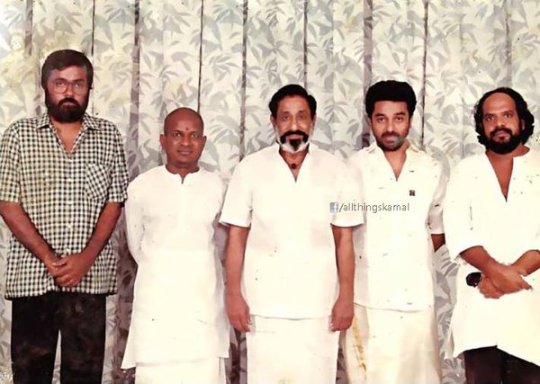
The dialogues, the casting and the environ of the film were masterfully compiled. That’s what gives the film a feeling of absolute completeness. The rurality of the Tamil language coupled with the apt interpretation of the Thevar mindset and body language, Thevar Magan gives you an unadulterated, authentic, rural Tamil Nadu experience.
a. The Cinematography
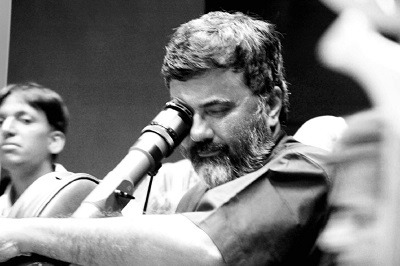
When I close my eyes and think the words ‘Thevar Magan’, a blue sky and a lush, rural greenery occupy my consciousness.
Living in an urban area, heat islands, rude autowallahs, and unforgiving traffic rules our day to day lives. Sure, some people love this chaos and the hustle-bustle, but a lot of us inherently crave sanctuary and tranquility that a countryside represents.
What I find really interesting in P.C. Sriram’s cinematography is the subtlety in his mastery over Paradox. The great cinematographic theme of the film is that of Paradox because the story moves counterintuitively to the richness and the serenity of the visual. It almost imposes upon the viewer the idea that even in a land of peace and quiet rivers of blood could most definitely flow.
The locations at which the film was shot are not just aesthetically well-thought but often times plays the silent role of moving the story forward.
b. The Music
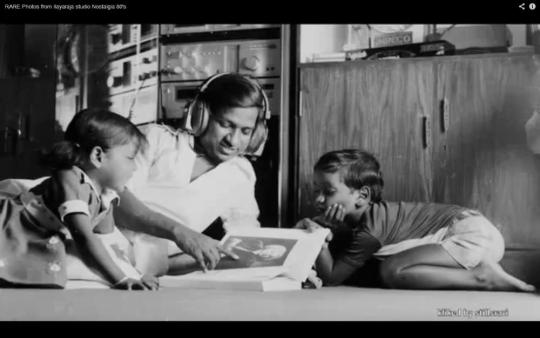
In terms of sound, Ilaiyaraaja’s score and soundtracks are still held in high regard among the masses. It can be said that the maestro managed to capture the complete spectrum of life that goes on in the film sonically.
To understand and appreciate the value and impact of Ilaiyaraaja’s musical contributions to the film we need to walk down the same path the maestro intuitively takes while composing - and this path can most suitably be described in terms of a Chinese Landscape Painting.

The small human figures depicted against crags, rivers, and mountains are portrayed thus so as to inspire the viewer to focus on the man and then try and imagine the surrounding landscape through his eyes. And this is how Chinese Paintings are designed to be read.
While a painting refers to that which is visual, Ilaiyaraaja employs the same organizing principles to deal with the realm of sound.
The crags, rivers, and mountains are replaced by lyric, melody and rhythm.
Ilaiyaraaja is the first rasika of the filmmaker. His ability to empathize deeply with the characters and their arcs in a story have yielded some of the greatest soundtracks in Indian Cinema. And Thevar Magan is no exception.
There is an element of sophisticated minimalism in Ilaiyaraaja’s work on the film. The most dominant characteristic of all the tracks on the film is the combination of balance and emphasis given to meter, melody, and rhythm.
c. The Notion of ‘Complete’
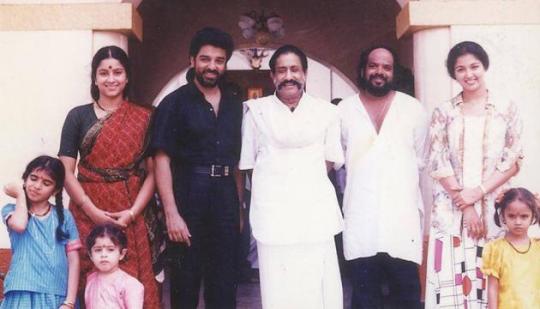
And finally, there are people who claim that Thevar Magan is the most complete film amongst all of Kamal Haasan’s work. While I am horribly one of those people who hasn’t yet watched Kamal’s entire body of work, I can quite understand what is implied by the term ‘complete’.
This notion of ‘complete’ emerges from a powerful idea of the story being structured in the form of a novel at its heart. According to Orhan Pamuk, “In well-constructed novels, everything is connected to everything else, and this entire web of relations both forms the atmosphere of the book and points towards its secret center.” Thevar Magan performs the same functions in an audio-visual format.
In conclusion, I’d like to say that I have done my best to understand what forms the atmosphere of the film as well as made several attempts to point towards what may be the secret center of the film.
*Thevar Magan was India’s official entry to the 65th Academy Awards in the Best Foreign Language Film category. Unfortunately, it was not nominated.

This work is licensed under a
Creative Commons Attribution-ShareAlike 4.0 International License.
#kamal haasan#thevar magan#thefilmreview#film#movie#review#sivaji#ganesan#nassar#tamil cinema#cinema#gouthami#revathy#ilaiyaraaja#p.c. sriram#cinematography#music#direction#soundtrack#artist#art#bharathan#culture#community#india#tamil nadu#indian cinema#academy awards#chinese landscape#painting
0 notes